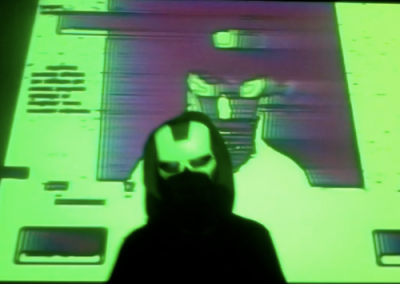
<P3RF
id=dither_d00m//
apocalypse_consume_mayan new media>
At first the artists are only four pairs of eyes floating in the darkness. Framed by black hoods and white masks, glowing with a sick and unearthly green. They sit at a long table covered by criss-crossing cables and wires that plug into an array of laptops, mixers, amps and other devices that defy easy categorization. The room thrums with sound reverberating from a stack of speakers. Crackling static and waves of neon green light projected against a wall-sized screen mark the start of the performance. The artists bend over their controls, their bodies swaying to an esoteric rhythm, a flurry of twisted knobs and keystrokes. As they frenetically adjust and re-adjust, the imagery grows more complex, waves of color crash into each other, rebound and cascade down before rising again. Suddenly everything goes monochrome then becomes a vibrating pulse of tessellating images.
What follows is part Dirty New Media treatise, part apocalyptic auguring and part transmission from distant or future selves. The crackling static is interrupted by long, wailing drones and messages distorted into a robotic voice: “Dither Doom is a social tumor,” “Is it possible to see a ripple without defining its shape?,” “Dither Doom is the frozen leftovers of nineties youth culture.” The green pallor remains but is overlaid by cryptic, flashing images: inverted cross, pentagram and waves of loading data. Distorted .gifs appear: a woman performing fellatio, a nude woman bound and crawling on the floor, a person sliding on a “gimp” mask. The sound is a mechanical hum, the music of a car factory two decibels too loud. As the imagery gets more complex the sound follows suit. Squealing high-pitched notes stab at the eardrum and interrupt the mechanical grinding.
The chaos builds as the artists work furiously, shaping, twisting and amplifying the distorted imagery and sound. The result is a gut-twisting sonic and visual cannonade. At times the confluence of text and image is beautiful and thought provoking. At other times it is a graphic and sonic assault that pierces the threshold of perceptual endurance. When it seems like the speakers can’t possibly hold, the volume rises again, and again. As abruptly as it all began, the performance comes to a halt. A cry rises from the audience. Part celebration, part exhalation of relief. </P3RF>
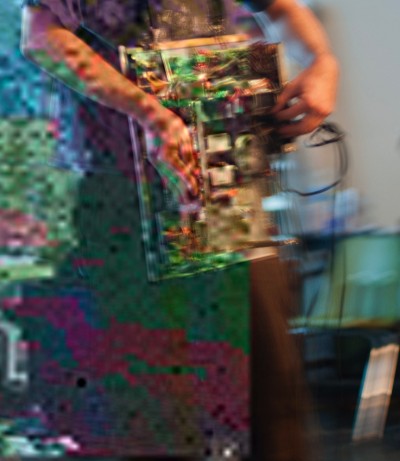
<D3F_1
id=GL1TCH//
disrupt_manipulate_bake>
The term glitch refers to a fault within an electronic system that causes an unexpected result. Computer glitches occur when a program is given a set of instructions outside the parameters it is designed to accommodate. The computer then either shuts down, refuses to operate, or outputs something unusual or unexpected. It is this last outcome that forms the basis of glitch art.
In her work “Glitch Studies Manifesto,” the artist and writer Rosa Menkman describes glitch as the subversion of expectations within a system. “The computer is a closed assemblage based on a genealogy of conventions,” she writes, “while at the same time the computer is actually a machine that can be bent or used in many different ways.” Yet, glitch art isn’t enthusiastically destructive in nature. Instead, glitch artists tend to work alongside or just outside the flow of expected outcomes. As Menkman writes, “The perfect glitch shows how destruction can change into the creation of something original.”
Glitch art gained momentum in the 1990s as the proliferation of digital technology in daily life became widespread and those with curiosity and skill in electrical wiring and programming began to tinker with their devices. Slowly the “accidental” output of these altered systems gained aesthetic cache — the errors could be sometimes beautiful, sometimes profound. Putting a file type into a program that isn’t meant to handle it can create the simplest forms of glitch art. For example, with a few simple tweaks to “Preferences” you can upload a photo file into the audio program Audacity, apply audio effects and then export the file. The resulting image will retain many of the elements of the original file but the structure or color will be accentuated or distorted.
Glitches of this type abound for the clever and curious, but for those who devote themselves to the theory and practice of glitch art, it goes much deeper. For some, tweaking and distorting programs is an act of anti-capitalist protest or an anarchic attempt to upset assumptions about systems of thought and expression. Others find a pseudo-spiritual satisfaction in communicating with the “Ghost in the Machine.”
Ryan T. Dunn and William Robertson are two Chicago-based glitch artists who operate Tritriangle, a performative media space and one of the hosts of the international glitch festival GLI.TC/H 2112. Robertson has a background studying the systems that define our lives and our universe: psychology and physics. He was drawn to glitch art as a way to systematically interrogate the relationships between people and machines. For him, the manipulation of electronic devices is a way to invoke the “schizophrenic nature” of the device. And since a human is curating the glitch event, a conversation ensues between the impulses of both subjects. One of his video installations, titled “A time and place” involves a TV hung on a wall with a small camera above it. As you step in front you see yourself from the perspective of the camera, but just as quickly the screen flickers and your image is replaced with that of someone who came before (or so you assume). The faster you move, the faster the subject changes, and you get the sense you’re trapped in a distorted time warp. Your sense of time and place and even existence is suddenly up for debate.
Ryan T. Dunn considers himself a born tinkerer. For as long as he can remember, he has taken apart and reassembled mechanical objects. One of his recurring pieces, “Instinct Control,” consists of live improvisational performance where he manipulates an unmodified reel-to-reel tape player. “(I try to) actively anthropomorphize a machine and access pan-psychism,” he told me, “The machine itself has an identity, a represented voice. It’s me in conversation with the device.” When Dunn performs the piece his eyes tend to close and his mind appears transported. He bends and twists in tune with the amplified sound emanating from the reel-to-reel slung over his shoulder. His fingers complete the analog circuitry as if he were playing an inside-out piano. The product of this conversation between man and machine can be alternately soothing or hysterical, while touching on the spectrum of emotion in between.
When asked to define glitch art, Dunn and Robertson were difficult to pin down. “The community of glitch is so broad and inclusive that you can’t really single out any one thing,” said Robertson. “Glitch is an existing living structure. It has no definable state. It has to do with some kind of system that is experiencing a moment of brokenness. There is something about breaking a system,” offered Dunn.
Glitch art is caught in a difficult moment for an art movement. It remains on the boundaries of traditional art practice and theory, but as it gains prominence and practitioners there is an impulse from within and without to begin codifying the principles that define the art. Glitch art comes from a perversely anti-authoritative DIY (Do-It-Yourself) aesthetic that spurs easy categorization. As such, individuals within the scene are often averse to applying any rules to what is or is not glitch art. </D3F_1>
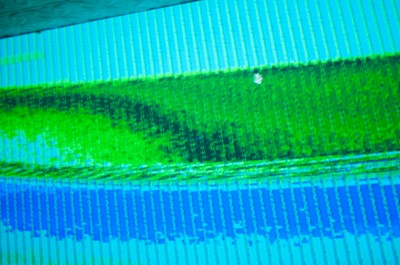
<ISSU3_1
id=N3W_A3STH3TIC//
br!z_cats_dron3s>
The rise in prominence for glitch and Dirty New Media can be partially attributed to a phenomenon termed “The New Aesthetic” by British technology writer James Bridle. At the 2012 SXSW conference Bridle published a paper and organized a panel that discussed his contention that the products of technological devices have become so popular as to alter the principles of contemporary aesthetics and create a new “way of seeing.” For example, a decade ago it was nearly impossible to find photographs of the earth from above. Today, thanks to Google Earth, users can zoom around and get detailed views of nearly every corner of our once foreign and isolated home planet. Aesthetics attributed to some glitch art, like pixelated imagery and distorted photographs, also fall under the umbrella of Bridle’s “The New Aesthetic.”
When Bridle introduced these concepts he ignited a firestorm of controversy that caught the attention of Nick Briz, SAIC alum, current teacher and GLIT.C/H organizer. In the ideas of “The New Aesthetic” Briz found a current of thought that underlined his own artistic practices. Briz had watched the principles of glitch art slowly gain popularity, mostly online, over the last decade. For Briz, this proliferation of glitch-themed work still carried the cachet of newness. The work was not always insightful or original and most were what he calls “new media one-liners,” interesting only because of the illusion of “newness.”
In response, Briz created “thenewawesthetic.js.” On his website he describes the project as: “an executable-essay, open-source javascript artware-library for quick reproduction of new aesthetic compositions and related new media art tropes.” In layman’s terms, Briz has created a set of digital tools that makes it easy for anyone with basic programming knowledge to create “glitch” artwork. Some of the executable effects include the ability to pixelize a gif, use out-of-date icons (like the spinning hourglass) and “glitch” a photograph by disrupting its component parts. Essentially, Briz pulled back the curtain of his own art practice, exposing its inner-workings for all to see.
For Briz, demystifying glitch practices wasn’t a profoundly political statement. He acknowledges that there are elements of political awareness in his work, but it is not his sole purpose. He is more attuned to the open-source community that touts the freedom of information as its highest dictum. But most importantly he is fighting to stem the flash flood of art from what he calls “unconsidered practices.” “If you make something stupid, you can no longer be stupid about it, it shaves off some of the aura,” he told the panel at GLI.TC/H 2112. By revealing the techniques behind much of the glitch aesthetic he knew he could be “killing his art,” but was something so precious and vulnerable worth saving? Instead he is pushing his community to make something bigger, better. </ISSU3_1>

<D3F_2
id=D1RTY N3W M3DIA//
anti-_(im)perfection_historic>
The terms glitch and Dirty New Media are often paired but are not interchangeable. “Dirty New Media is the bastard stepchild of glitch,” says SAIC student Shawne Holloway. “The stepchild who smokes pot with the Mayor’s daughter before prom.” Dirty New Media incorporates many elements of glitch theory and function but also finds precedents in punk culture, DIY aesthetics, pornography and digital piracy.
The idea of “new media art” has existed since the invention of photography. Traces of the artistic experimentation that informed Eadweard Muybridge’s zoopraxiscope, Surrealist film experiments, and the video art of the 1980s, all appear in the practices of today’s digital new media artists. The term “Dirty New Media” was coined by artist, musician, and Chair of the Film, Video and New Media and Animation (FVNMA) program at SAIC, Jon Cates to describe a specific thrust of new media art focused on the intentional aestheticizing of disjointed images that have been all but eradicated by technological advances. The average prime time television commercial being the perfect counter-example: everything is lit brightly, the scenes cut seamlessly into one another, the music and dialogue is engineered into a flawless and cohesive whole.
Dirty New Media works toward subverting expectations and creating tension between the subject and the aural and visual elements we take for granted. Audio may be disrupted and not synched to imagery. The image itself may be blurry or pixelated. These are not flaws, but intentional disruptions. Pixelated images and distorted sounds can reveal internal structures of meaning that are otherwise invisible. Content-wise Dirty New Media tends to be aggressive, if not overtly pornographic at times.
While the products of glitch art practices are diverse, there is an expectation that for something to be properly termed “glitch” it must be the result of a subverted, bent or otherwise manipulated technology. While Dirty New Media artists may utilize glitch methods in their practices, this is just one of the tools at their disposal. The formal achievements of Dirty New Media may be equal to those achieved in glitch art, but that isn’t the primary focus. The emphasis is instead on emotive content over form. Dirty New Media work tends to aim for something immediate in the emotional register, foregrounding the gut-punch over technical acuity. </DEF_2>
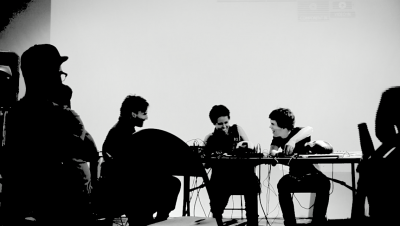
<ISSU3_2
id=CHICAGO SCHOOL//
m3cca_gli.tc/h_ch!cag0 sch00l>
Chicago has a long history of being an international center for new media experimentation and, more recently, glitch art. In the early 1970s the artists Phil Morton, who founded SAIC’s Video Data Bank, and UIC’s Dan Sandin, inventor of the Sandin Image Processor, an early machine founded on glitch principles, began a close history of collaboration. According to an article on the history of Dirty New Media, written by Joel Kuennen for ArtSlant, Morton and Sandin wrote a treatise called “Distribution Religion” wherein they laid out their principles for open-source sharing of technology, innovation and theory. This ethos of an open-source community remains an organizing principle around the glitch and Dirty New Media scene in Chicago today. In her writing, Rosa Menkman has referred to Chicago as “(the) ‘pivotal axis’ of the international glitchscene(s).” She has also coined the term “Chicago School of Glitch.”
What the “School” in “Chicago School of Glitch” refers to is open to debate. Yet it is impossible to dismiss the recurring presence of current and former SAIC students and faculty at the forefront of the glitch art and Dirty New Media scenes, both in Chicago and globally. This recent groundswell of innovation centered around SAIC can be traced to the programming and institutional support of Jon Cates. Cates has been organizing glitch art and Dirty New Media-related festivals and exhibitions in and around Chicago since the late 1990s. Prominent glitch artists Jon Satrom and Nick Briz were students of Cates’ and now both teach in the FVNMA program at SAIC. Satrom and Briz, along with Rosa Menkman are also the organizers of GLI.TC/H one of the premier Glitch “conferences,” the third iteration of which occurred in various locations around Chicago from December 6 through 9, 2012.
Under the direction of Cates, SAIC has become a community-based training ground for a diverse roster of new media artists. The strong sense of open-source sharing and collaboration attracts artists from a diverse range of backgrounds — painters, sound artists, designers and more. The low-level of entry, one need only rudimentary programming or design skills to execute simple glitches, belies the furiously expanding ceiling for innovation. The technological tools used in glitch art in a constant state flux, creating an environment where students instructors are always innovating in exciting new ways. </ISSU3_2>
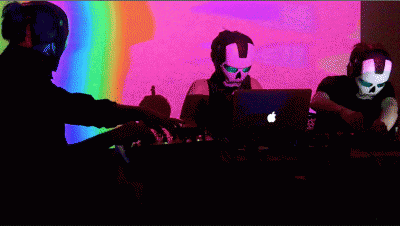
<P3RF_EXP
id=dither_d00m
(be)cause_endtim3s_hydra>
Upon inception, dither_d00m was something like a joke. A finger in the eye of online artists, like those involved in “seapunk” or “Greek New Media,” who become involved in micro art movements that go “viral” and are a topic of discussion for a month, a week or a day, then disappear just as quickly.
Ditherd00m was created by a cabal of SAIC undergraduates who prefer a veil of anonymity. Not to protect their identities but instead to reinforce the idea of community-driven innovation. The members felt repelled by the superficial quality of digital art in the aforementioned “seapunk” vein. They decided to create a self-aware movement embracing the paranoia surrounding the “Mayan Apocalypse” that was to occur on December 21, 2012. They began creating work within aesthetic boundaries evoked by the nihilistic mindset of a decadent culture perched on the brink of sudden and irrevocable destruction. They re-appropriated apocalyptic symbols from diverse cultures and combined that with imagery that invoked contemporary overconsumption. They also embraced the idea of an accelerated “internet lifetime” and made it their raison d’etre. If the world was set to end in fiery hailstorm on December 21, 2012, so would their “movement.” (Whether the hailstorm manifested itself or not.)
As powerful ideas tend to do, dither doom quickly expanded outside its humble origins. Their work rasped against the exposed nerve of something both primal and contemporary, something intrinsically digital but also timeless. The creators built a tumblr page and put out calls for work from their diverse community of collaborators. Responses came in growing waves and before long digital artists completely removed from the original circle (and located around the world) began contributing. Sub-movements like “glitter doom” and “dither fetish” arose in response. By embracing the evanescent nature of Internet culture, the “joke” began to resemble something authentic. All the while the clock ticked on.
“When was the last time a glitch work made you sad, has it moved anyone to tears, has it elated them beyond belief into a manic state of excitement?” wrote Imam Muradi in his essay, “Glitchbreak.” Critics of glitch art and Dirty New Media contend that too much of the art produced is little more than ironic or technological play and experimentation. Muradi was one of the first academics to engage glitch art, so it may be helpful to recast his statement as not a critique, but a call-to-action — an attempt to motivate artists away from “unconsidered practices” and embrace cultural, political and aesthetic interrogation.
The members of dither_doom are among the first generation of adults raised in a world where technological devices are everywhere and the New Aesthetic represents not a shift, but the status quo. As such they are armed with preternatural skill and willingness to manipulate both electronic systems and complicated media forms. Dither doom may have begun as farce, but as the artists continued pushing their self-ascribed boundaries they found themselves engaged in a portentous critique of consumer culture, digital art practices and even the tenets of glitch art. Their works can disturb, but can also push the viewer toward moments of isolated reflection: What is shocking? What is appealing? Is feeling nothing worse than feeling everything? They’ve scraped the errata from the bottom of our shared digital world, amplified and twisted its sickness and shoved it back into our faces, crying out: “Look what you’ve become.”
Like all provocateurs, d1therd00m must balance questions of whether the heuristic value of their work justifies the use of profane and degrading imagery. But what is incontrovertible is the realization that the new generation of glitch and Dirty New Media artists possess the tools, if not always the willingness, to create art that can move an audience, if not to wonderment then at least to tears. </P3RF_EXP>







any videos of this on youtube?
Why have you not given credit to the artists whose work you have documented?
Here’s dither doom in Knoxville in 2012: https://vimeo.com/53971302